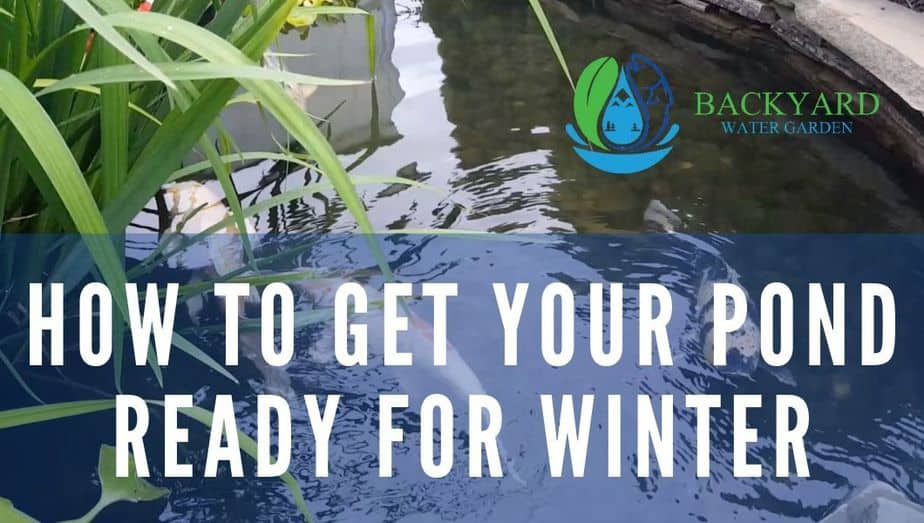
Ready or not it’s that time of year again. The days are getting shorter and temperatures are getting cooler with every passing day. That can only mean one thing. It’s time to get your pond ready for winter.
This may not be as exciting as the spring time prep. It’s a necessary evil if you want to keep your fish healthy and your water feature looking its best.
Expert Advice
We were lucky enough to stop in at Hahn’s Ponds for their annual pond closing seminar. Check out the video below.
When Do I Stop Feeding My Fish
When autumn hits, start weening fish off their summer feeding schedule. I feed my fish once a day during the summer months. When the season changes I slow down to about 3 times per week. When the water temperature reaches 40 – 45 degrees F stop feeding your koi and goldfish.

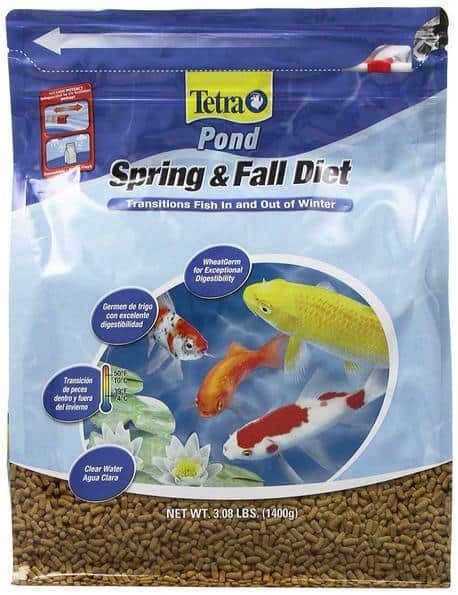
Changing the food to a spring / fall blend of fish food is important too. The seasonal food offers empty carbs. This helps fatten up your fish to make it through the cold winter.
Changing their diet and the frequency in which they eat helps to ease them into the cold season. When the temperature begins to drop your fishes metabolism slows down. With a slower metabolism, the food high in protein could actually begin rot inside them. Avoid this by changing their food.
How Deep Does My Pond Need To Be
Check the USDA hardiness zone map (link to the zone map of the USA) to see what zone you live in.
Deeper is always better, but guidelines for our zone (zone 6) is a depth of at least three feet. Keeping fish outside over winter is less stressful on the fish, and easier on you. Goldfish may survive in shallower water as long as there is an aerator to keep a hole in the ice.
Most people think that fish die because of the cold temperatures during the winter. The truth is they perish from suffocation. The build up of organic sludge produces poisonous gasses. If these gases get trapped under the ice your fish cannot breathe.
Avoid Tea Time
Remove dead leaves and muck from the bottom before the cold weather sets in. This will help keep your fish alive in the months ahead. Remember the old saying “an ounce of prevention is worth a pound of cure”. This was exactly what they were talking about!
Stop the leaves from getting into your water in the first place. Using a pond net (link to Amazon) will save you tons of work. Be sure to put it on before the leaves start falling.
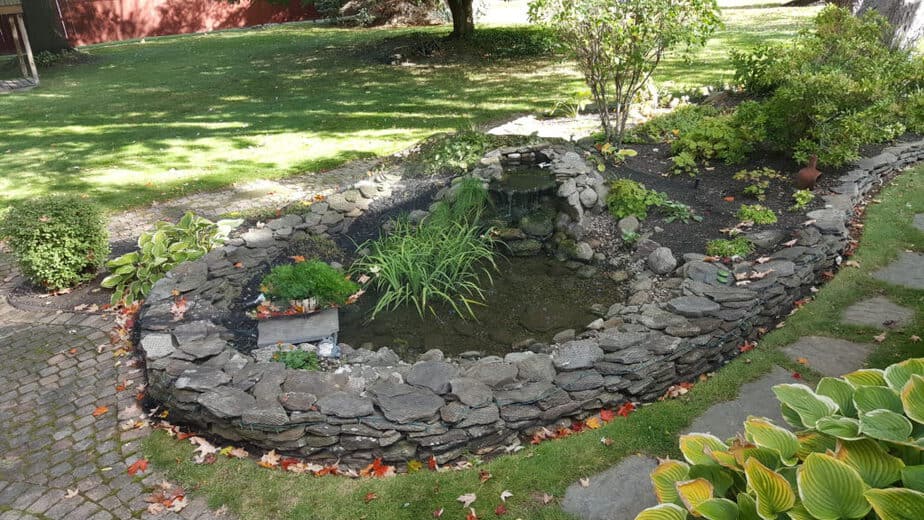
Keep the leaves from building up on the net. Heavy leaves will cause your net to sag into the water. If this happens, it acts like a giant tea bag.
The tannins from the leaves seep into the water turning it a rusty brown color. If this happens, the only way to get your water clear is through a significant water change.
The easiest way to keep the leaves from building up on the net is to use a leaf blower (link to Amazon). This will remove the leaves without disturbing the netting. Remove the net as soon as most of the leaves have fallen.
Muck Control
Guess where your fish go when it gets cold? They stay close to the bottom in a dormant state. That’s where all the muck and debris rests too. Muck and debris build up is one of the most hazardous things for your fish over the winter season is.

When the weather gets cold your fish metabolism slows down. Because of the lower temperature beneficial bacteria growth also slows down. As the muck and debris breaks down over the winter, it produces harmful gases. Harmful bacteria also resides there in a dormant state.
When the spring arrives, and things begin to come back to life your fish may appear healthy. Then without warning they begin to die off. This is usually caused by the harmful bacteria no longer being dormant.
There are a couple ways to defend against this. You can be sure to remove as much muck and debris in the fall. Muck Off (link to Amazon for the best price) is a product that claims to reduce 2 inches of muck per season. These are tablets you run through your waterfall system throughout the season.
Fighting Disease
Adding salt to your pond (link to our pond salt article) is another measure you can take to protect your fish.

The pond salt (link to Amazon for price and availability) will boost the immune system of your fish. It will help them fight off infection in the spring. The salt will also reduce the growth of harmful bacteria and parasites.
One concern of using salt in your pond is the effect it has on your pond plants. During the fall and winter your plants are dormant. Because of this, you can use a higher dose of salt for the winter months.
You will need to do a partial water change in the spring to lower the salt level before your plants come back to life.
Give Your Plants a Haircut
At this point in the season you should have stopped fertilizing your plants. Some plants have already begun to discolor and fade. Plants like water lilies (link to article on water lilies) trimmed before they fall to the bottom adding to the sludge.

Trim down any other bog plants right above the water line. Removing the trimmings will stop them from contributing to the muck on the bottom.
Getting Through The Cold
When people hear of fish perishing in the winter, freezing to death is their first assumption. This is false, fish are more likely to die from suffocation. The most important thing to keeping your fish alive through winter is to keep a hole in the ice.
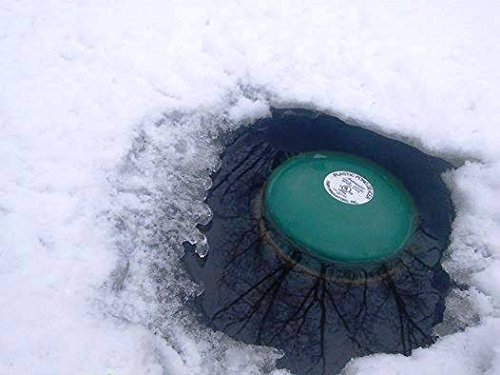
You may opt to use a “pond heater”, but they aren’t like you might think. They do not warm the entire pond. In reality it is a pond deicer (link to Amazon). Their function is to keep a hole in the ice around them so poisonous gasses can vent out of the water.
Do not use a trough heater like the ones used for livestock. While this may seem like a great idea, they will melt your pond liner if it comes in contact with it. They also use a lot of power.
Our number one recommendation is to use an aerator (link to our article about pond aeration). Place the aerator should at a mid level depth. On one of your planting shelves. This is so super cooled air is not introduced into the lowest layer of your pond where your fish are.
The aerator will introduce oxygen into the water through the winter. More importantly, it will agitate the surface, and prevent the formation of ice.
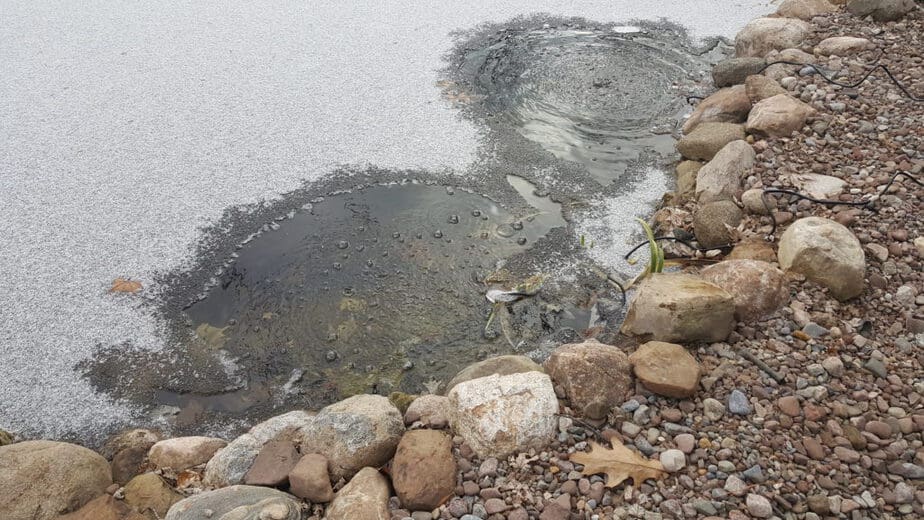
Keep an eye on your pond during cold spells. Even when using an aerator, your pond may still freeze over. If this happens use a hammer or shovel (be careful not to hit your liner) and break the ice above the aerator. The ice will be thinner there, and easier to break.
The best, most effective method is to use these two things in conjunction with each other. Place your heater over your air stone. The agitation will keep the heater from getting stuck in the ice. This will ensure that your pond water is vented all winter long.
Pull Out All Your Equipment
Lights in and around your pond can stay put year round. Seeing a warm glow beneath the snow and ice has an enchanting effect. The one light that needs to come out is your UV light (link to our UV light article) if you have one.
The crystal tube that houses your bulb will not make it through the cold. Even if you choose to run your waterfall all winter I still advise removing your UV light. If you have your UV light installed (UV light installation video) the right way this shouldn’t be an issue.
Now is also a great time to take it apart and clean the glass so you are ready for next season. It’s much easier to clean now than it will be in the spring after everything has dried and hardened to the glass. Save your future self some work and do it now.
Pull The Pump
When you are closing down your pond for the season, it’s also a good time to clean out your pump. Remove your pump from your return line and pull it out. It’s amazing how much muck, algae and even roots collect on the intake.
If you have a check valve installed in your system, you need to make sure all the water drains from your lines. If it doesn’t they could freeze and crack.

A check valve allows the water to only flow one way. If you remove your pump and not much water comes out of your lines you will need to locate your check valve and remove it. Once your check valve is disengaged all the water in your system will drain from the lines.
Running Through Winter
In my neck of the woods (near Buffalo New York) you can get away with running your pond and waterfall all winter long. Yes we get a significant snowfall. But our temperatures don’t drop below sub zero for any length of time.
If you live somewhere exceptionally cold, running all winter might not be an option for you.
There is something romantic and majestic watching a waterfall in the winter landscape. If you choose to run yours all winter you will need to keep an eye on the ice formation around your waterfall.
It’s possible for your waterfall to freeze in such a way that it actually diverts water out of your pond. If this happens, your pump could run dry and burn out. This is the last thing you want to deal with in the dead of winter.
Key Takeaways
- Remove as much debris and leaves as possible
- Trim back all vegetation
- Use a salt treatment to prevent disease
- Remove your equipment (pump and UV light)
- Install aerator and/or heater
Conclusion
It’s always sad when the season has come to an end. Follow these simple guidelines and keep your fish healthy through the cold months ahead. Also giving you a much easier time when starting things up in the spring.


